LG Optimus 2X Review
LG Optimus 2X
It's officially the world's first dual-core smartphone but more crucially, is it the best?
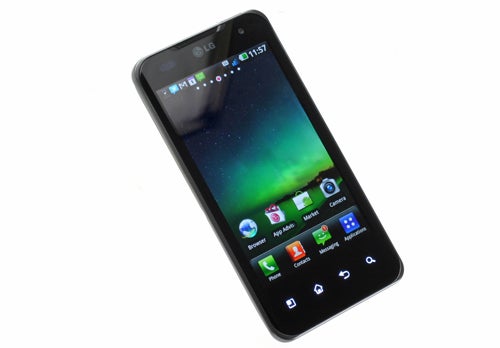
Verdict
Pros
- Superb build quality
- Packed with hardware features
- Super fast dual-core processor
Cons
- Only runs Android 2.2
- No camera shutter button
- Button layout could be better
Key Specifications
- Review Price: £347.00
- 4in LCD screen
- Android 2.2 Operating System
- 1GHz dual-core processor
- 8 megapixel camera
First impressions are very good. The whole front of the phone is taken up be a massive slab of glass that tapers off at its left and right edges. The effect is lovely and really sets the Optimus 2X apart from its competitors. The rest of the handset also pleases thanks to the metal strip that runs round its edge, the soft touch plastic back, and the further strip of metal that breaks up the monotony of the back. With a generally sturdy feel to its plastic body to boot, it just exudes class.
One downside of all these premium materials is the phone’s weight, at least compared to the featherweight Samsung Galaxy S II that we also have on our desk at the moment. At 139g, the Optimus is 23g heavier than the Galaxy, though it’s only 2g heavier than the iPhone 4. Similarly it’s not the slimmest handset at 10.9mm but it certainly doesn’t feel bulky and in fact we almost prefer the slightly thicker stance as it feels comfortable and well planted in the hand.
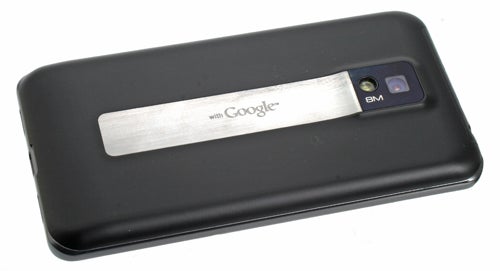
It’s not all good though. The touch sensitive buttons running under the screen look nice by not breaking up the surface of that swathe of glass, but the lack of physical buttons does mean you always have to stretch to the power button on the top edge to activate and deactivate the phone’s screen – and it’s a long reach. We really don’t know why some smartphone manufacturers (and it does seem to be a particular problem with Androids) still haven’t picked up on this really basic ergonomics issue. This is certainly one reason to prefer the Samsung Galaxy S II to this phone.
Similarly, we’re miffed not to see a camera shutter button on the phone’s edge. We really hoped that once Microsoft stipulated one as a minimum requirement for its Windows Phones the rest of the smartphone world would’ve taken heed. Sadly not.


Otherwise we have no further complaints about the general styling and features. There are all the standard ports we’d expect with microUSB nestled between the microphone and speaker on the bottom edge (another neat design trick, even if it is stolen from Apple) and miniHDMI (for mirroring the phone’s display and playing back video on an HDTV) and a headphone socket on the top edge. A microSD slot is also hidden below the battery cover, which comprises the whole plastic back section that prizes off via a fingernail notch on the bottom edge. There’s 8GB of internal storage and up to 32GB more can be added with microSD.
The volume buttons sit on the right edge and, like the power button, have a nice clicky action so you know when you’ve pressed them, making them easy to pick out by feel along – always useful when trying to adjust volume when the phone’s in your pocket.
Turn the screen of the LG Optimus 2X on and while good, it doesn’t immediately leap out as being something really special. That said, the 4in IPS LCD panel has strong colours, good contrast, a sufficiently dark black level and essentially infinite viewing angles. The main issues are that the resolution of 480 x 800 pixels looks just a little soft on such a large screen (particularly compared to an iPhone 4) and its colours and contrast can’t quite match that of the Super AMOLED displays on devices like the Samsung Galaxy S II. We really are being picky here, though, and it’s excellent for everything smartphone, from watching video to browsing the web.
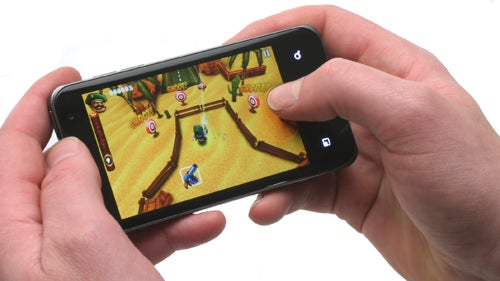
Of course, one of the key components of this phone is its dual-core processor, which is an Nvidia Tegra 2 model. This combines two 1GHz, ARM-derived CPUs with Nvidia graphics for a super speedy device, at least in theory. In general use, the extra performance isn’t immediately obvious with the lag from apps loading and little menu animations being about the same as single core phones.
Although this does make some sense as most of the operating system and apps don’t really take advantage of two cores – instead most apps are single threaded – there’s another reason this phone doesn’t particularly blow us away with its performance; it runs Android 2.2. One of the key advancements in Android 2.3 was the tautening up of general navigation elements, removing the slight stuttering that occurred as you moved round the interface. It was all subtle stuff but noticeable.
It’s a bit of a disappointment then to find the Optimus 2X coming with such an old version of Android (despite being only 0.1 behind the current version, it’s nearly a year old). The reason for such an old version is that LG has done a fair amount of tweaking of the interface.
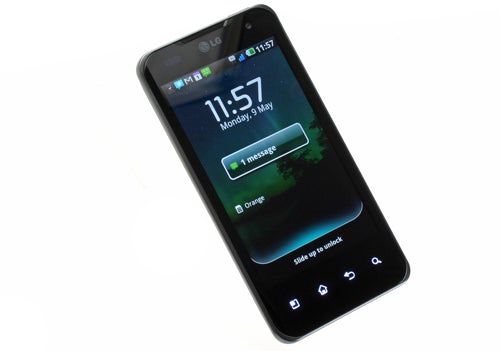
Right from the off things are a bit different. The lock screen for instance requires a slide upwards to unlock, rather than a swipe across.
The general interface looks much like standard Android with a central homescreen ready to fill with widgets and three further screens off to each side. Along the bottom are shortcuts for the Phone, Contacts, Messaging, and other Applications. Unlike some devices, you can’t change these to be apps of your own choosing, which is a bit of a pain.
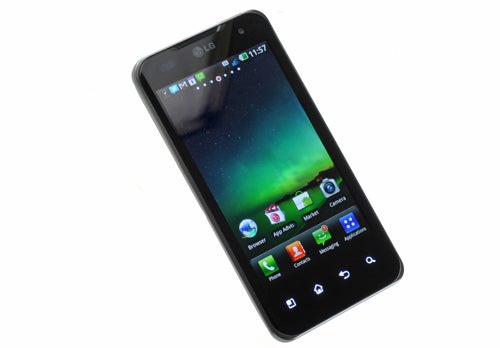
Where the next obvious difference occurs is when you dive into the Applications menu. Here LG has separated out all the standard apps from ones you’ve downloaded, which is quite useful for finding the latest game or utility you’ve downloaded. Once found you can then drag it to a homescreen or a folder of apps on the homescreen, just like on most other Androids. Thankfully LG hasn’t changed the applications list into a paginated layout, as seems to be common now, from its default of a single long list, which we prefer.
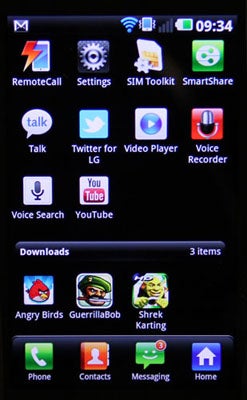
Another change is the notifications drop down menu, which as well as showing your latest emails and other messages, has a small music player for quickly playing/pausing or skipping a track and a series of five icons for quickly changing some useful settings; Silent Mode, Wi-Fi, Bluetooth, GPS, Auto Rotate. All useful additions.
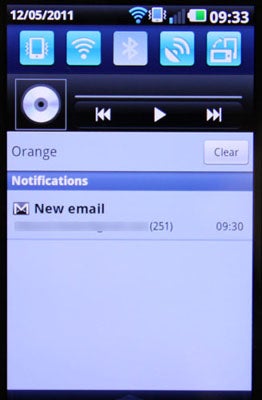
All told the general interface feels intuitive and easy to use with a few nice additions over and above standard Android. An update to Android 2.3 can’t come soon enough though as there are enough little tweaks on the latest version that make all the difference.
As we’ve come to expect of Android’s, you can add Facebook and Twitter information to your existing contacts, and the phone does a pretty decent job of matching up the contacts, making it easy to contact your friends in many different ways as quickly as possible. You can of course import and export contacts from SIM or SD cards as well.
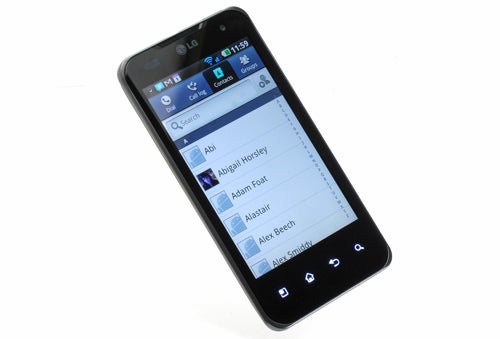
What you don’t get is a single integrated messages app that brings in social network messages. SMS are instead handled by the standard Android app, which simply stores your messages in conversation style and date order. Meanwhile, you can add a social network feed widget to the homescreen but this separates out the two services into two columns and doesn’t provide any other particularly useful functions. Essentially, you’re going to want to jump into the full Facebook and Twitter apps to get the most from those services.
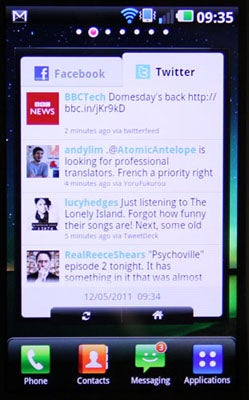
Email support is as comprehensive as ever with POP3, IMAP, and exchange all onboard. Setup is generally as easy as simply putting in your email address and your username and password, with the phone working out the rest. There are separate apps for Gmail (which will be automatically populated once you log into your main google account on the phone) and another one for all other emails. However, the second one has a better interface and also supports Gmail so it’s worth setting up all your accounts on that one app and easily accessing them all at once from there. We do miss not having the split screen landscape mode on the Sony Ericsson Xperia Arc, but as this is the only phone we’ve seen with this, it’s harsh to call the Optimus out on this too much.
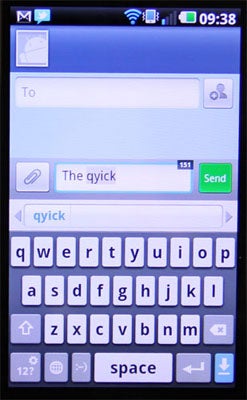
The overall typing experience is okay. The onscreen portrait keyboard is well laid out and, thanks to the responsive screen and speedy processor, keeps up with even the speediest typing. The width of the phone’s screen helps here as it allows just that little bit more room for your fingers to manoeuvre without mashing two keys at once. However, you need every ounce of that extra accuracy as the predictive texting isn’t as good as the likes of the iPhone or alternative Androids. You can download alternative keyboards, but it’s something of a pain that you may find you have to.
The web browser is as good as we’ve come to expect with speedy accurate rendering of pages and full support for Flash right out of the box. Indeed thanks to the fast processor, Flash is that much more usable than on other handsets. It’s still not perfect – most Flash games are still difficult to interact with – but it’s definitely a step in the right direction and of course trumps the iPhone.
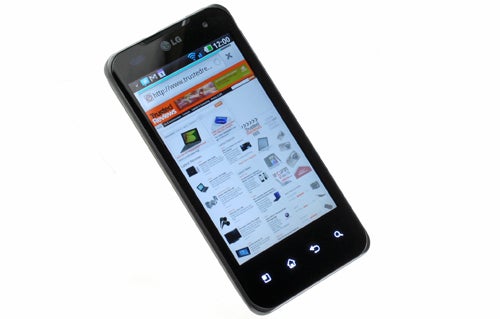
However, as with the rest of the interface, due seemingly to the older version of Android, navigation is just a bit jerky. Pinch to zoom in and out or scroll up and down and it just stutters ever so slightly, whereas other Androids of this calibre are free of this. We’re not sure about the super slim ‘.’ and ‘/’ buttons on the keyboard when entering an address either. So again, it’s clearly a very good experience but just not quite the best.
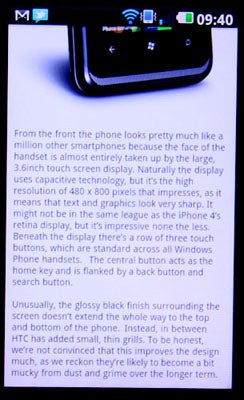
We’re seeing more and more Androids copy the iPhone style double tap to zoom implementation whereby the screen resizes to the size of the picture or section you double tapped on. Not so with the Optimus 2X, instead it zooms into a sensible distance for easy reading when you double tap on a block of text. It also reflows the text to fit the width of the screen so you don’t have to scroll left and right. Both methods high their positives but we tend to prefer that used by this phone.
As you’d expect 3G and 802.11b/g/n Wi-Fi are onboard so general browsing speed is decent, signal permitting.
The default selection of apps on the LG Optimus 2X is good with all the basic personal data organising utilities like calendar and notes on hand. Google’s selection of navigation apps, including GoogleMaps and Navigation are also ready and waiting along with a music player, video player and gallery. You also get a few interesting extras like F-Secure anti-virus, while a folder labelled ‘Preloaded Apps’ has a selection of games, the Kindle app, a calorie counter and a few others. These give the impression of being downloaded onto the device but in the case of the games, while they initially install instantly, once you start them up you need to download all the game data. At least they’re free, though.
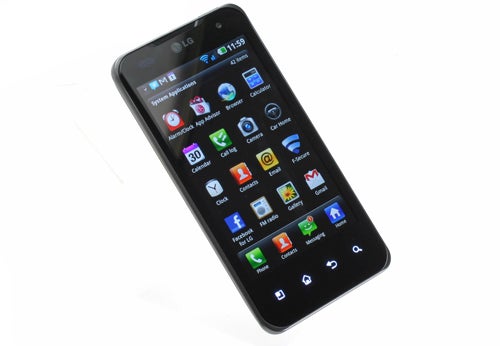
Multimedia support is reasonable with divx and xvid supported for video, though mkv isn’t recognised. Up to 720p video mostly plays back without a hitch and looks glorious. However, really high bit rate 720p video and 1080p content is too much for it. As ever we also find the standard Android gallery interface to be far too much about form than function.
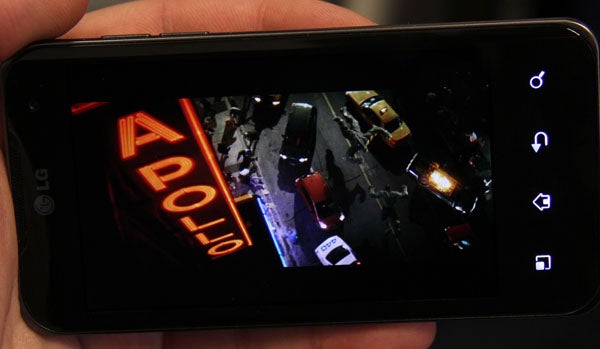
Audio is restricted to mp3, wma and aac, with ogg and flac unavailable. The music player is easy enough to use, though, and the mini player available in the notifications drop down is a real boon. We do miss the iPhone’s ability to double tap the central button to open the music controls, though.
Android MarketPlace gives you access to hundreds of thousands of apps so you can get the LG Optimus 2X chock full of useful and time wasting doohickeys. However, it’s not an entirely easy process. Dive into the MarketPlace and you can be rummaging around for an age to find the best apps. Not that the iPhone platform is perfect in this regard but unless you know the app you’re looking for Android’s MarketPlace is worse. Once you know which apps you want, it’s a breeze to install them and arrange them all over your homescreens as you see fit.

One of the most obvious tests for this phone’s dual-core processor was trying some games and while they looked good and ran smoothly, the advantage over single-core alternatives wasn’t blindingly obvious. Most of the test games run just as well on the likes of the Sony Ericsson Xperia Play. The Optimus 2X is just that bit nippier when it comes to loading the games and technically it does have more power under its hood but right now it’s not being taken advantage of.
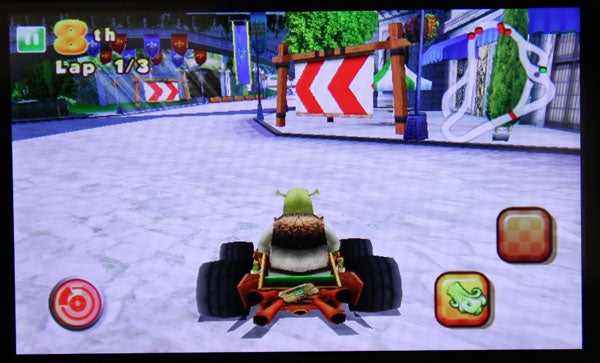
One of the most disappointing aspects of this phone for gaming was the speaker, which doesn’t get particularly loud and distorts when at full volume. This doesn’t make it great for conference calling either, though normal conversation using the ear piece is fine – there’s no active noise cancelling, though, so it’s not the best for noisy environments.
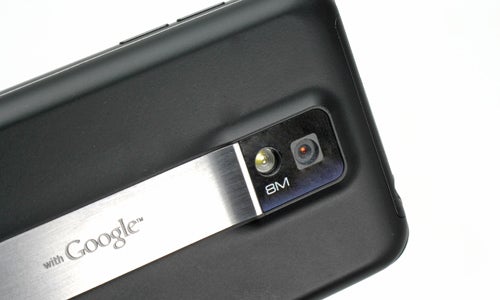
The camera, which like so many of these devices, fools you into thinking it’s good thanks to the bright and sharp screen. However, open up your shots on a computer or get them printed out and you’ll find them somewhat lacking. That said, there’s definitely more detail on offer from this 8 megapixel snapper than you get on most 5 megapixel models and the app itself is easy to use with plenty of shooting modes like continuous and smile shot as well as scenes.
1080p video is also available and similarly it’s a step up in quality from more typical smartphones, with just a bit more detail and punch to its colours while motion is smooth.
Battery life is one area where you might expect these dual-core phones to trail their single-core counterparts, though manufacturers of these chips have said they could actually have the opposite effect. In our tests, we found the device to be fairly typical for an Android phone, with intensive use and having everything turned on resulting in it struggling to last more than a day and a half but if you manage your data usage in particular it will last for several days comfortably.
As to the reported issues with freezing and crashing, we experienced no such thing, at least giving some credence to LG’s claims that it’s not a universal problem.
”’Verdict”’
The LG Optimus 2X is an excellent phone. Its styling is lovely, it packs in oodles of high-end hardware and thanks to its Android OS, it’s hugely versatile. However, LG has made a few too many slip ups for it to really hit the top spot. Nontheless, particularly thanks to it being a bit cheaper than the competition, if you’re looking for a true smartphone powerhouse, it’s well worth considering.






How we test phones
We test every mobile phone we review thoroughly. We use industry standard tests to compare features properly and we use the phone as our main device over the review period. We’ll always tell you what we find and we never, ever, accept money to review a product.
Trusted Score
Score in detail
-
Performance 9
-
Design 8
-
Value 10
-
Features 9
General
| Operating System | Android OS |
| Height (Millimeter) | 123.9mm |
| Width (Millimeter) | 63.2mm |
| Depth (Millimeter) | 10.9mm |
| Weight (Gram) | 139g |
| Available Colours | Black |
Display
| Screen Size (inches) (Inch) | 4in |
| Screen Resolution | 480 x 800 |
| Touchscreen | Yes, glass capacitive |
Battery
| Talk Time (Minute) | 420m |
| Standby Time (Hour) | 400hr |
Storage
| Internal Storage (Gigabyte) | 8GB |
| Camera (Megapixel) | 8 Megapixel |
| Front Facing Camera (Megapixel) | Yes Megapixel |
| Camera Flash | 1 x LED |
Connectivity
| Bluetooth | Yes |
| WiFi | Yes |
| 3G/4G | Yes |
| 3.5mm Headphone Jack | Yes |
| Charging/Computer Connection | microUSB |
Processor and Internal Specs
| CPU | 2 x 1GHz, Nvidia Tegra 2 |
Misc
| App Store | Yes |
| GPS | Yes |

